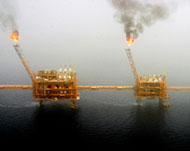Non-Opec nations fail to pump more oil
Non-Opec nations are failing to deliver as much oil as expected this year despite record high crude prices, leaving already stretched Opec to fill the supply void.

The Internarional Energy Agency ( IEA) on Thurdsay, adviser on energy to 26 industrialised nations, also nudged up its world oil demand growth forecasts for this year and the next in a monthly report.
“Until the desire to hold more stocks is sated or the conditions that cause that are changed, the market will be looking for more supply and it will be looking to OPEC,” said Lawrence Eagles, head of the IEA’s oil market division.
For their part, non-Opec countries are falling behind in their deliveries of new oil.
Non-Opec countries are set to pump only 675,000 barrels per day (bpd) of fresh oil this year, sharply down on the additional 1.1 million bpd in 2004, said the energy watchdog.
The Paris-based agency cut non-Opec supply growth this year by 205,000 bpd, with unscheduled outages in the US Gulf, Mexico, Norway and the UK accounting for 150,000 bpd of the lower estimate.
Production expectations
Russia, Africa and the Asia-Pacific region are also producing less than expected.
 |
|
Russia, Africa and Asia-Pacific |
The picture is expected to brighten in 2006, with non-Opec supplies set to rebound to 1.25 million bpd. But that projection is also revised down from last month’s report by 150,000 bpd.
With non-Opec offering only slim new volumes, Opec may need to turn up the taps. That responsibility would lie solely with top world oil exporter Saudi Arabia, the only Opec member with significant spare capacity.
The IEA reckons the kingdom holds 1 to 1.5 million bpd of mostly medium to heavy sour crude oil in reserve. But world refiners struggling to churn out light transport fuels are shunning those heavier barrels.
Oil demand
The IEA raised its requirement on Opec crude for the fourth quarter, the seasonal peak in demand, by 300,000 barrels per day (bpd) to 29.2 million bpd.
Opec already exceeded that level in July, having pumped 29.6 million bpd, said the IEA.
“Stocks have built rapidly in the first half of 2005, despite $60 oil, but clearly, the market verdict remains that more inventories are needed until investment responses catch up and demand patterns are clearer.”
Downward adjustments to non-Opec 2006 supply have also pushed up the call for the year to 28.3 million bpd, a 200,000 bpd upward revision.
The energy watchdog applauded Opec’s efforts to stabilise markets by boosting production, but criticised the cartel’s slow investment in new production capacity.
Record high prices
“Moves to put in place a more comfortable spare capacity cushion … seem to have slowed considerably in the past few years, recent Saudi expansions notwithstanding,” the report said.
 |
|
The projected growth of world oil |
World oil prices have sped to record highs above $65 a barrel despite high production levels from Opec.
The IEA also nudged up its world oil demand growth forecasts for this year and next.
The projection for growth in world oil demand for this year and next is largely unchanged at 1.6 million bpd, up 20,000 bpd, and 1.78 million bpd – a 30,000 bpd increase – respectively.
Weaker Chinese apparent demand is expected to be partly offset by a modest adjustment to US data.
The IEA cut its forecast for China‘s oil demand this year and next, citing early signs that third quarter growth in oil consumption would be lower than expected.